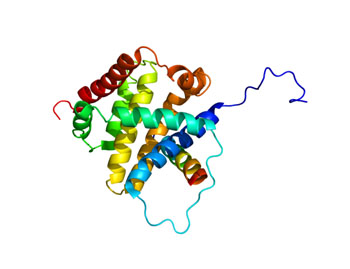Levels of Bim Protein in T-cells Reflect Success of Anti–PD-1 Cancer Therapy
By LabMedica International staff writers
Posted on 16 May 2016
Measurement of levels of Bim (BCL-2-interacting mediator of cell death) protein in circulating T-cells of cancer patients may provide a less invasive strategy to predict and monitor responses to anti–PD-1 therapy.Posted on 16 May 2016
Immune checkpoint therapy with PD-1 (Programmed cell death protein 1) blockade has emerged as an effective therapy for many advanced cancers; however, only a small fraction of patients achieve long-term responses. There is no validated blood-based means of predicting the response to PD-1 blockade.

Image: A structural model of the Bim protein (Photo courtesy of Wikimedia Commons).
PD-1, functioning as an immune checkpoint, plays an important role in down regulating the immune system by preventing the activation of T-cells, which in turn reduces autoimmunity and promotes self-tolerance. The inhibitory effect of PD-1 is accomplished through a dual mechanism of promoting apoptosis (programmed cell death) in antigen specific T-cells in lymph nodes while simultaneously reducing apoptosis in regulatory T cells (suppressor T cells).
Investigators at the Mayo Clinic (Rochester, MN, USA) had previously cloned PD-L1 (Programmed death-ligand 1) and found that tumor-associated PD-L1 mediated tumor immune evasion. Since then the group has been working on dissecting the molecular mechanisms of the PD-L1/PD-1 pathway in T-cell dysfunction.
They recently reported that they had identified the protein Bim as a downstream signaling molecule of the PD-1 pathway and that its detection in T-cells was significantly associated with expression of PD-1 and effector T-cell markers. Thus, high levels of Bim in circulating tumor-reactive T-cells were prognostic of poor survival in patients with metastatic melanoma who did not receive anti–PD-1 therapy and were also predictive of clinical benefit in patients with metastatic melanoma who received anti–PD-1 therapy in the form of the humanized monoclonal antibody drug pembrolizumab. This circulating tumor-reactive T-cell population significantly decreased after successful anti–PD-1 therapy.
"Our previous research demonstrated that Bim is a downstream signaling molecule in the PD-1 signaling pathway, and that levels of Bim reflect the degree of PD-1 interaction with its ligand PD-L1," said senior author Dr. Haidong Dong, associate professor of immunology at the Mayo Clinic. "We hypothesized that the increased frequency of CD8+PD-1+Bim+T cells in patients who respond to immunotherapy reflects an increased number of target T-cells for PD-1 blockade with pembrolizumab, which may explain the positive clinical outcomes in these patients."
The study was published in the May 5, 2016, online edition of the journal JCI Insight.
Related Links:
Mayo Clinic













